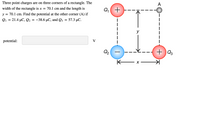Question

Transcribed Image Text:Three point charges are on three corners of a rectangle. The
A
width of the rectangle is x = 70.1 cm and the length is
Q +
y =
= 70.1 cm. Find the potential at the other corner (A) if
Q1 = 21.4 µC, Q2
-38.6 μC and Q
57.3 µC.
y
potential:
V
Q2
+ ) Q3
K x –
Expert Solution
This question has been solved!
Explore an expertly crafted, step-by-step solution for a thorough understanding of key concepts.
This is a popular solution
Trending nowThis is a popular solution!
Step by stepSolved in 2 steps with 1 images

Knowledge Booster
Similar questions
- The question is attached, I attempted it myself multiple times but was unsuccessful. Thanksarrow_forwardProblem 10: The diagram shows one positive charge, Q+ negative charge,Q- P4. The relative positions are indicated. In all steps, assume that the potential function of the point charge has been defined so that the potential goes to zero at very large distances. = +4.23 µC, one = -12.27 µC, and four observation points, P1, P2 ,P3, and PA 3 сm E4 cm- 4 cm -2 cm- Q+ P1 P2 2 cm-3 cm Pa Part (a) What is the potential, in kilovolts, at observation point P1? Numeric : A numeric value is expected and not an expression. V = Part (b) What is the potential, in kilovolts, at observation point P2? Numeric : A numeric value is expected and not an expression. %3D Part (c) What is the potential, in kilovolts, at observation point P3? Numeric : A numeric value is expected and not an expression. V = Part (d) What is the potential, in kilovolts, at observation point P4? Numeric : A numeric value is expected and not an expression. %3Darrow_forward9 √13 (μC) and q₂ = 3 (μC) are placed at the points 0(0, 0) and A(x, 0) meters as shown in the figure. The electrical potential at the point P(0, 2) meter is zero volts (VP = 0 V). Calculate the location of charge q₂- Q-1 Two point charges q₁ = лу P(0, 2) O(OA) X 91=- g (pc) V13 92= 3 (ME) A(x,0) 92arrow_forward
- In the region shown in the image, there is a uniform electric field of magnitude 17.3 N/C which points in the positive ?‑direction. Points 2, 3, and 4 are all 0.749 m away from point 1, and the angle ?=46.4°. Calculate the following potential differences ??−??, where ? and ? indicate the numbered points. ?2−?1= ____ V ?3−?1= ____ V ?4−?1= ____ V ?2−?4= ____ Varrow_forwardTwo point charges, +3.40 µC and -8.90 µC, are separated by 3.10 m. What is the electric potential midway between them? Number Units Aarrow_forwardSee attached image for picture that accompanies the problem. Three point charges q1 = 65 nC, q2 = -130 nC, and q3 = 195 nCare arranged at the corners of a square of side a = 10.0 cm. Whatis the potential at the 4th corner, point A, assuming V = 0 at r = ∞?arrow_forward
- 1arrow_forwardQUESTION 5 A thin rod has a non-uniform charge per unit length given by 10) = a x, where a= 45. 0 nC/m, is distributed along the x axis from x +2.00 cm to x = +8.00 cm. If the electric potential at infinity is taken to be zero, wnat is the electric potentiai at the point P on the x-axis at x=15.0 cm? O A. 49.1 mV O B. 2.70 kVv O C. 243 V O D. None of the given options O E. 250 Varrow_forwardTwo point charges, +2.70 µC and -7.40 μC, are separated by 1.70 m. What is the electric potential midway between them? Number i Toxtbook and M Unitsarrow_forward
- 1) Given the charge distribution below, determine the potential at A (upper left corner of the triangle and B (middle of the right edge of the rectangle). A -30 µC B. 7.5 cm 23.0 cm +10 uC +90 µCarrow_forwardm7df7 > $ 4 R F An isolated charged soap bubble of radius Ro= 5.25 cm has a potential of Vo = 231.0 V at its surface. If the bubble shrinks to a radius that is 27.0% of the initial radius, by how much AU does its electrostatic potential energy change? ▬▬ V Assume that the charge on the bubble is spread evenly over the surface, and that the total charge on the bubble remains constant. Use k = 8.99 x 10° N-m²/C² for the Coulomb force constant. Q Search % 5 FS T G O D A 6 B Y H & 7 N U 8 M 9 K DE O (DOLL prt sc AU = home B B 0 P ? end num lock 7 Po 4 1 CE 11:00 PM 2/18/20244 8 J 5 +/- O 2 9 PRE 3arrow_forwardA solid sphere of radius a=7 cm and dielectric constant ɛ=3.8 has a uniform volume charge Por density of po-29 nC/m2. The electric field is given by E(r) = Poa³ r>a The potential at the center of the sphere is. O a. 45.46 V O b. 60.62 V O c. 6.06 V O d. 30.31 V O e. 15.15 V O f.4.55 Varrow_forward
arrow_back_ios
SEE MORE QUESTIONS
arrow_forward_ios